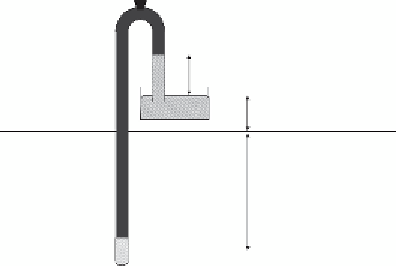Geoscience Reference
In-Depth Information
l
Mercury reservoir
Water
∆
z
1
Soil surface
∆
z
2
Ceramic cup
Figure 4.28
Tensiometer with mercury manometer.
interface in the reservoir where the pressure head is zero, and moving through the
manometer to the cup:
h
=− ++
12 6
. ∆∆
l
z
z
(4.46)
1
2
Question 4.20:
Two tensiometers are installed in a soil proile and connected to the same
mercury reservoir. The cups of tensiometers 1 and 2 are at depths 40 and 80 cm, respec-
tively. The mercury level in the reservoir is at 10 cm above the soil surface. The length of
the mercury column in tensiometer 1 is 7.5 cm and that of tensiometer 2 is 9.0 cm.
a) Draw the potential diagram assuming
H
is linear with
z
.
b) Calculate the height of the groundwater table.
c) What do you expect of the mercury levels in the manometer tubes when the water in
the soil is at static equilibrium?
Nowadays, pressure transducers are frequently used instead of pressure gauges of
mercury manometers. A pressure transducer has a sensitive membrane, which con-
verts liquid pressures into voltages. With these devices pressure heads can be mea-
sured very accurately and automatically registered. Also pressure transducers require
very small displacements of their sensing element to register changing pressures.
Therefore tensiometers with pressure transducers require only minute volumes of
liquid lowing into or out of the tensiometer cup, which makes them much more
sensitive than, for instance, mercury manometers. Although high sensitivity is very
desirable in the vadose zone with its small soil water luxes, one negative effect is that
readings are more strongly inluenced by changing temperatures, mainly due to ther-
mal expansion and contraction of the liquid and tubing.
The lowest soil water pressure head that can be measured with tensiometers is equal
to the vapour pressure of water (-977 cm at 20 °C). In practice, however, already at
pressure heads below -900 cm problems arise due to expansion of gas bubbles. The
measurement range of tensiometers is limited further by the size of the largest pores

Search WWH ::

Custom Search